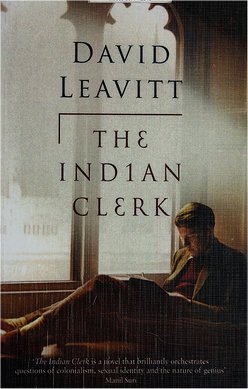Mathematical Cipher:
The Indian Clerk

For the first fifty or so pages of David Leavitt’s 2007 novel The Indian Clerk I found myself thinking that this would make a decent Merchant-Ivory film; and that’s a good thing, because I’m a big admirer of those movies. A hundred pages later I was thinking that it would probably be one of their more boring ones; and by the time that I put this 500 page slab of a book down I wondered why anyone would want to bother filming it.
Obviously the person who did the cover is hoping it will hit the silver screen at some stage because they have Kenneth Brannagh’s double reclining languidly, looking tweedy and bookish.
It is the story of the real-life English mathematician G. H. Hardy, who in 1913 received a letter from Srinivasa Ramanujan, a young clerk in India who just happened to be a genius. With his collaborator Littlewood he brings him to Cambridge where he hopes to solve the Riemann hypothesis.
Now I’m not exaggerating when I tell you that Mathematics was far and away my very worst subject at school. I lived in mortal fear of that double period that we used to do on Monday mornings. Dear God, that was torture. Nor had I ever heard of the principle characters here, but that was OK because my interest was stimulated by the fact that they were moving in a set that included such notables as Wittgenstein, D. H. Lawrence and Bertrand Russell. I’m a sucker for that kind of thing.
[Just as an aside, isn’t it funny how some people just don’t need a first name? Brando, De Niro, Wittgenstein. I’m just saying, like.]Well, there’s a chapter where Lawrence comes off sounding like a serious pain in the ass and they all get to have some cameo appearances, but the plain fact is that this reader at least was never moved to identify with any of the characters—not Alice Neville, who seems to be in love with Ramanujan, not Littlewood, who has his own miseries of the heart; and certainly not Hardy himself, the atheist who gets visits from his dead gay lover.
They all seem to revolve around Ramanujan, yet the Indian mathematician himself is barely there. He remains a cipher, not a character; as cold, remote and icy as one of the equations that Leavitt occasionally throws out at us. Yet there are glimmerings here: for example, there is a superb scene in an Indian tearoom involving a waiter, Mrs. Neville and a crow. It is all too brief but in those few pages India and the very nature of colonialism seemed to come close to being tackled. And what kept me reading was Leavitt’s depiction of how the Great War touches every character. It is always offstage, never do we see anything at first hand and yet I have rarely found myself gripped by just how insane the whole thing was.
Perhaps I’m not really the audience that the book is aimed at but I found myself closing The Indian Clerk thinking that I could have been reading something else. Still, I did finish it, so I guess that says something.


Recent Comments